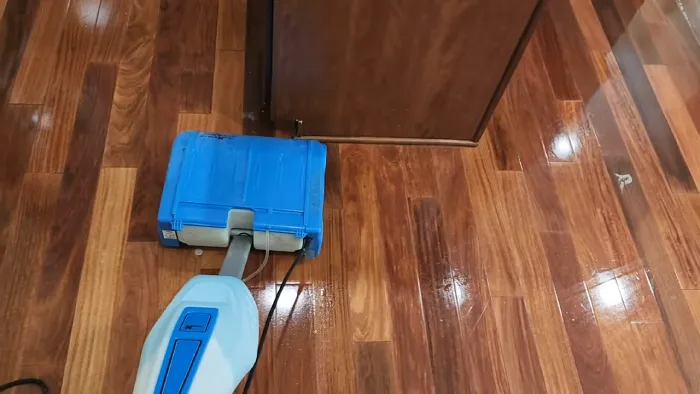How to Remove Fire Sprinkler Cover Plate: 3 Simple Steps
Fire sprinkler cover plates keep sprinkler heads from getting damaged, ensuring proper operation. But over time, these cover plates can become covered in dust mites. This can delay the sprinkler’s response time, which could be disastrous in the event of a fire.
By removing the cover plate and cleaning the glass bulb and sprinklers, you can ensure that your fire sprinkler will be ready to act quickly in the event of a fire. Occasionally, you will have to remove these cover plates if you wish to enhance the appearance of your indoor environment.
But how do you remove fire sprinkler cover plates for cleaning or beautifying an indoor space? You can easily remove a fire sprinkler cover plate in minutes by following a few simple steps. Check out this article to find out how to remove the fire sprinkler cover plate.
How to Remove Fire Sprinkler Cover Plate to Improve Indoor Aesthetics?
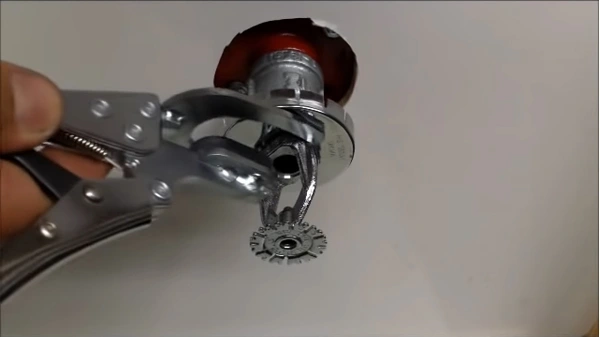
The fire sprinkler cover plate is an aesthetic feature often installed indoors to cover up the unsightly pipes and valves associated with the fire sprinkler system. Most fire sprinkler cover plates are flush with the ceiling and attached to a framed piece, screwed, or pushed into the sprinkler head assembly.
If you are looking for a way to improve the aesthetics of your home or office, you may want to consider removing the fire sprinkler cover plate. Removing a fire sprinkler cover plate can quickly be done with a few tools and simple steps.
You will need a screwdriver or a putty knife to remove the rivets or soldering holding the plate. Now follow the below steps:
Step 01. Locate the screws on the frame:
Before removing the cover plate, you must identify the screws. There are typically three to four screws, one in each corner. Once you have found the screws, you need to unscrew them with a Phillips or flathead screwdriver.
Step 02. Unscrew the frame with a screwdriver:
Use the screwdriver to remove the screws that hold the plate. Be careful not to strip the screws, making it difficult to replace the plate. With the screws removed, you should be able to lift off the cover plate gently.
Step 03. Use a putty knife to cut the solder:
You can cut it with a putty or kitchen knife on a fire sprinkler cover plate. To do this, first identify the spot where you need to cut. Then, hold the putty knife carefully and use the blade to score the solder.
Apply pressure on the handle of the putty knife and push down on the score line. The blade should easily slice through the solder. Once the plate is loose, you can simply pull it off. You can use a cloth to wipe away any excess solder.
In some cases, you may be able to remove your thread-adapted cover plates by simply turning them in the anti-clockwise direction.
Can You Replace the Old Metal Fire Sprinkler Cover Plate?
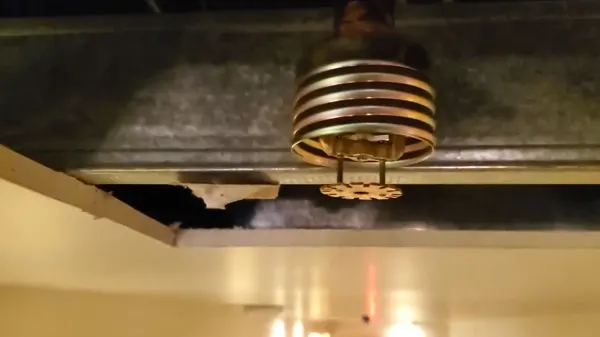
If you have an older metal fire sprinkler cover plate, you may wonder if you can replace it with a new one. The answer is yes; you can replace the rusted metal fire sprinkler cover with a new one. Regardless, there are a few things you need to keep in mind when doing so:
- The new cover plate should have the same size as the old one.
- Check that the new cover plate has the exact holding mechanism as the old one.
- There should be the same screw holes as the previous one.
- Verify that the new cover plate is compatible with the fire extinguisher sprinkler system.
If all of these things are considered, replacing the rusted fire sprinkler cover plate with a new one should not be a problem.
Can You Cover Fire Sprinkler Heads?

As an integral part of any fire extinguisher system, fire sprinkler heads should always be free of obstacles. A broken fire sprinkler glass bulb can cause severe flooding and damage your property. For this reason, cover plates may be required to protect fire sprinkler heads in some cases.
Cover plates can help protect the sprinkler head from accidental damage and give the ceiling a more finished look. If you cover concealed fire sprinkler heads, be sure to use approved cover plates rated for the specific model of the sprinkler head.
Also, ensure that the cover plates are securely fastened and do not impede the operation of the sprinkler head.
What are Fire Sprinkler Cover Plates?
Fire sprinkler cover plates are a significant part of the concealed sprinkler system. They serve an aesthetic and a protective purpose, hiding the rivets or screws that hold the fixture in place and providing a barrier against external damage.
They are made from various materials, including metal, plastic, and glass, and are available in multiple sizes and shapes to fit different types of fire sprinklers.
Cover plates help to keep the fire sprinklers clean and free of debris, and they also help to prevent damage to the sprinklers themselves. Also, a cover plate can help to reduce the spread of fire by preventing water from flowing through the openings in the fire sprinklers.
How Do Fire Sprinkler Cover Plates Work?
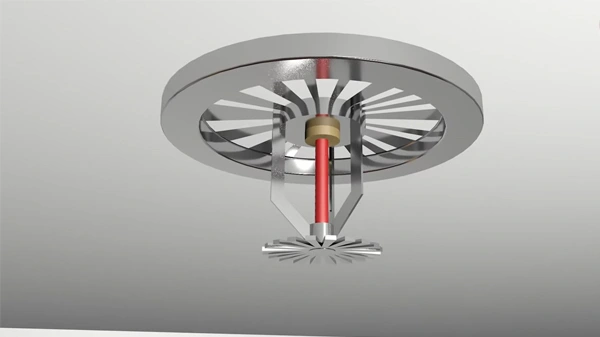
Fire sprinkler cover plates are attached to the system by a solder designed to melt at a lower temperature (usually 20 degrees Fahrenheit or lower) than the sprinkler heads. The solder is temperature sensitive, which ensures that when the solder melts, the concealed sprinkler heads activate.
The cover plates will fall away and allow the water to be distributed evenly across the room. In addition to protecting against dust particles, cover plates also help to prevent accidental activation of the sprinklers, ensuring that they will only be used in an emergency.
What are the Best Places to Use for the Fire Sprinkler Cover Plates?
Fire sprinkler cover plates are often found in buildings with high fire risk, such as those with highly flammable materials. But, they are also valuable for any building to improve the visual appeal of the indoor space.
Indoor locations such as airport hangars, processing plants, chemical plants, and data storage centers are good candidates for using fire sprinkler cover plates.
These places typically have high ceilings and a lot of equipment; these plates can help to reduce damage in these indoor locations by providing a barrier between the sprinkler heads and the equipment below.
Fire sprinkler cover plates can be used outdoors in parking garages, roofs, and other areas where the sprinklers are exposed to the elements. Cover plates can help to shelter sprinkler heads from wind, rain, and snow, keeping them clean and functioning correctly.
Also, cover plates can provide a measure of protection against vandals and birds that might otherwise damage or tamper with the sprinklers.
Are the Fire Sprinkler Escutcheon & Cover Plate the Same?
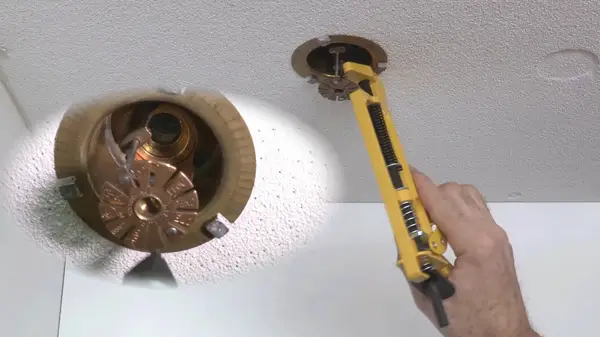
Regarding accessories for fire sprinkler heads, there are two main types: fire sprinkler cover plates and fire sprinkler escutcheons. These accessories serve different purposes, but they are often confused with one another.
A cover plate is a flat piece of material that covers the entire face of a fire sprinkler head. Cover plates are typically used when a sprinkler head is recessed into a wall or ceiling, as they help to protect the head from damage.
On the other hand, escutcheons are specifically designed to be visible around the periphery of a fire sprinkler head. It helps to give a finished look to a sprinkler space and can also be used to conceal minor imperfections in the surrounding wall or ceiling.
You should select the appropriate accessory for your fire sprinkler head. This is because using an escutcheon in place of a cover plate may impede the appearance of the interior.
Should the Fire Sprinkler Cover Plate be Replaced?
A fire sprinkler is a critical equipment in any commercial or residential building. The cover plate of a fire sprinkler is one of the most crucial parts, as it protects the sprinkler head from damage. Sprinklers may lose effectiveness as their cover plate wears out or becomes damaged.
Also, if the sprinkler manufacturer did not paint the cover plate, the cover plate must be replaced as the previously painted finish may hinder the performance of the fire sprinkler.
To prevent this situation from occurring, it is advisable to inspect the cover plate and, if needed, replace it. While replacing the cover plate may seem like a small task, it could make all the difference in an emergency.



